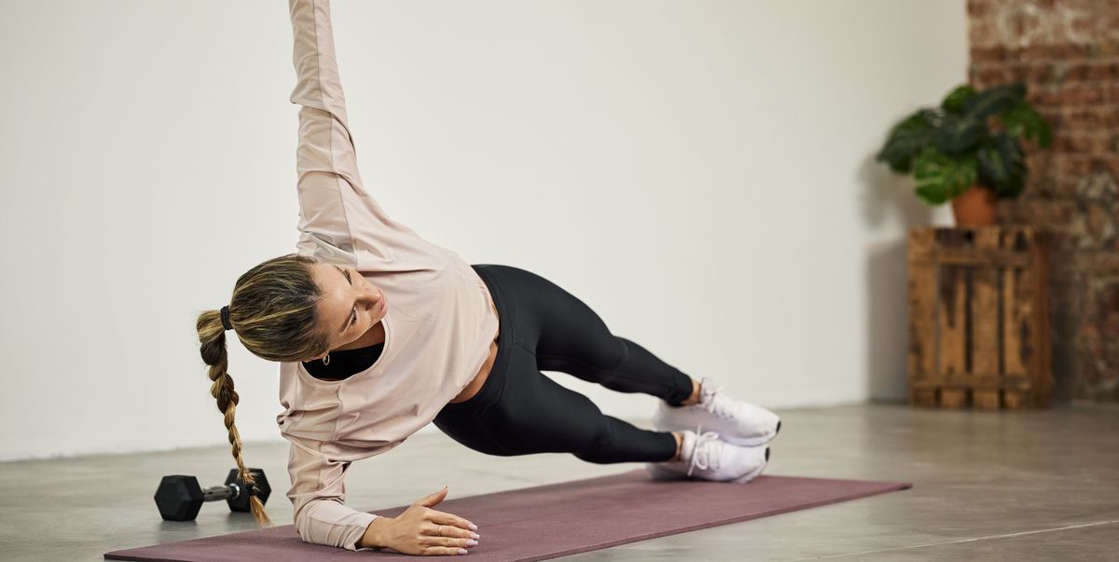What Are Isometric Exercises and How Do They Benefit Runners?

From squat jumps to snatches, you’d think that all you really need in your strength-training script to power your runs are exercises that require your muscles to move. After all, running itself is a dynamic sport that involves plenty of arm and leg coordination.
But some of the best performance-boosting exercises for runners don’t really involve movement at all. That’s right, they simply require you to stay steady instead—and those types of moves are called isometric exercises.
So, how can exercises that require you to just hold still help you run faster and longer? Read on to learn everything you need to know about isometrics, including benefits, the best isometric exercises for runners, and how to incorporate them into your workout routine.
What Are Isometric Exercises, Anyway?
Isometric exercises contract a muscle or group of muscles without changing length or altering the position of the joint (think: plank, wall sit, or hollow-body hold). When you’re holding a plank, for example, you’re firing your core to stabilize your body and squeezing your glutes and quads to enlist the lower body—but you aren’t moving, say, your arms or legs.
When performing an exercise, there are three different phases: concentric (shortening), isometric, and eccentric (lengthening). The isometric phase is the middle phase—after your muscle contracts but before it lengthens, says Jacqueline Elbaz, a NASM-certified personal trainer and USA Track & Field coach.
For example, when you’re doing a lunge, the eccentric phase is when you’re bending your knees and lowering your back knee toward the ground. When you push off of your front foot to stand back up, that’s the concentric phase. But after you lower down and before you stand back up, that’s the isometric hold.
5 Benefits of Isometric Exercises
Isometric exercises don’t involve intense movement, but that doesn’t mean they’re easier or less effective than other types of exercise. In fact, we have plenty of reasons why you should add them to your workout ASAP.
1. They build muscular endurance
Although your muscles aren’t lengthening or shortening during isometric exercise, they are still firing. This can help you build foundational strength for running, Elbaz says.
“[Isometric exercises] help build muscle because you’re performing a static exercise that requires the muscle to hold a certain position over a period of time,” Elbaz explains. “That constant tension on the muscle can help improve muscle endurance and strength.”
Muscular endurance is the key to helping you go the distance on your runs without breaking form or getting too fatigued. It trains your muscles to withstand tension (read: hard effort) mile after mile. Consider those long runs, where your posture might start to hunch over on later miles—isometric exercises like planks could help you counteract that, keeping you running stronger for longer.
2. You’ll improve core stability
Whether you’re doing three miles or 10, running requires core and hip stability to maintain posture and sustain repetitive movement for an extended period of time. When you’re pounding pavement, you enlist the muscles in your abdomen, lower back, and hips—a.k.a. your core—to stabilize your trunk and spine and keep the knees tracking forward. Because isometric exercises emphasize stability and form, they’re especially helpful in building your core and hips.
“Isometric exercises help us successfully find the right body position, and in doing so, we can more successfully train the tissues we want to train,” says Ben Lauder-Dykes, a Fhitting Room instructor and run coach. In the case of isometric exercises, you focus solely on improving stability, which makes stability during your runs easier.
Research also shows that doing core- and pelvic-strengthening exercises regularly can help improve race times and overall strength, according to a study in the Journal of Strength and Conditioning Research. In the study, 35 high school cross-country runners followed a six-week program that included isometric exercises, such as planks and 30-second ball squeezes (which work the inner thighs or adductors). Results showed that the runners improved their race times and muscle strength, particularly the core, glutes, and hip flexors.
3. You’ll lower risk of injury while boosting performance
By fortifying your core and lower-body muscles with isometric exercises, you’ll naturally improve the way your feet, ankles, knees, and hips function which can help you run more efficiently and avoid injury. Research supports the benefits of building up your core for injury prevention: At least one study points to limited core stability as increasing the risk of patellofemoral (or knee) pain in new runners.
Beyond gaining stabilization, isometric exercises may also support your tendons or the tissues that connect bone to muscle. “Tendon strength for runners is massively underrated not only on absorbing impact but also helping us move forward,” Lauder-Dykes explains. “When we make contact with the ground [while running], the tendons can absorb some of that energy and give it back to us to spring us up off the ground. This is referred to as energy return.” Boosting your energy return means spending less time on the ground, which translates to less effort from your muscles to run more efficiently and faster, Lauder-Dykes says. It also means less overall impact—a benefit for sprinters and marathoners alike when it comes to both performance and injury prevention.
Isometric exercises are also great for building unilateral (one side) strength and targeting muscle imbalances, which can also lead to injury, Elbaz says. For example, you can do side planks to strengthen your obliques on each side or split squat holds, focusing on a single leg, to power your glutes and quads.
4. You go easier on the Joints
While plyometric training can help runners build power, it’s taxing on the muscles, joints, and tendons. Because isometric exercises don’t involve any movement at the joint, they are inherently low impact. That’s why isometric training can be beneficial for those coming back from injury, those who have conditions like arthritis, or runners who want to get in some training on an active recovery day. Isometric exercises can also be an ideal training tool for strength newbies to help ease their muscles and joints into more activity.
In fact, a small study from the Journal of Strength & Conditioning Research demonstrated that doing isometric training can be just as effective as plyometric training in building tendon stiffness and muscle force output—minus the significant stresses on the body and higher risk of injury.
5. You’ll help to lower your blood pressure
Any type of exercise will help lower high blood pressure, but emerging research shows that isometric resistance training can be particularly effective.
Case in point: An August 2021 review in Hypertension Research found that isometric resistance training can help reduce blood pressure, and the risk of an adverse event while performing them is low. Although more trials are needed to support these findings, it’s safe to say that adding some planks and squat holds into your routine will do the body good in more ways than one.
Make sure you check with your doctor first before starting an exercise program, particularly if you have hypertension.
How to Incorporate Isometric Exercises into Your Workouts
Elbaz recommends runners incorporate isometric exercises after an easy run. “I always like to structure my runners’ days by load work. Easy runs with easy strength,” she says. “I categorize isometric exercises with easy strength, so after an easy run, I recommend doing five to eight isometric exercises for two rounds, holding each exercise for 30 seconds to a minute.”
Lauder-Dykes also suggests runners add isometric exercises to their warmup with some running drills and plyometric exercises. “Most people will benefit from doing it more frequently across the week,” he explains.
While you can simply hold isometric exercises like you would in a wall sit, you can also add isometric training to dynamic movements by pausing in the middle of the exercise. For example, when doing a hamstring curl, pause for a few seconds at the top of the movement when your hips are lifted and you bring your heels toward your butt. Or, in a squat, pause at the bottom for a few seconds, before standing back up.
As far as how long you should hold an isometric exercise? Elbaz says 30 seconds is a good place to start, slowly building your way up to a minute. Once you hit a full minute, add sets or load to make it more challenging. That said, as you increase time or load, you want to make sure you’re still doing the exercise with good form. Allowing your form to break can always up the risk of injury.
Some of the best isometric exercises for runners, according to Elbaz and Lauder-Dykes:
-
Isometric calf raise: Stand with feet hip-width apart. Lift the heels to come up to the toes. Hold here for at least 30 seconds.
-
Split squat hold: Stand with feet hip-width apart. Step right foot back. Bend both knees to 90 degrees, back knee hovering just off the ground. Hold here for at least 30 seconds. Then stand back up. Repeat on the other side.
-
Forearm plank: Start lying facedown. Place forearms on the floor, elbows under shoulders. Press the floor away to lift the entire body up, forming a straight line from shoulders to heels. Hold here for at least 30 seconds.
-
Foam roller hamstring bridge: Start lying faceup on the floor, knees bent and feet planted on top of a foam roller, ankles under knees. Engage glutes to lift hips up into a bridge position. Hold here for at least 30 seconds, engaging hamstrings and glutes the entire time.
-
Long-level hamstring bridge: Lie faceup with legs almost fully extended in front of you (slight bend in the knees) and arms on floor by sides. Dig heels into the ground and imagine dragging them toward your butt along the floor to create tension. (Hips stay on the floor.) Hold here for at least 30 seconds.
The post What Are Isometric Exercises and How Do They Benefit Runners? appeared first on Runner's World

